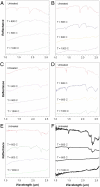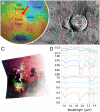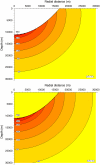Noachian and more recent phyllosilicates in impact craters on Mars
- PMID: 20616087
- PMCID: PMC2901452
- DOI: 10.1073/pnas.1002889107
Noachian and more recent phyllosilicates in impact craters on Mars
Abstract
Hundreds of impact craters on Mars contain diverse phyllosilicates, interpreted as excavation products of preexisting subsurface deposits following impact and crater formation. This has been used to argue that the conditions conducive to phyllosilicate synthesis, which require the presence of abundant and long-lasting liquid water, were only met early in the history of the planet, during the Noachian period (> 3.6 Gy ago), and that aqueous environments were widespread then. Here we test this hypothesis by examining the excavation process of hydrated minerals by impact events on Mars and analyzing the stability of phyllosilicates against the impact-induced thermal shock. To do so, we first compare the infrared spectra of thermally altered phyllosilicates with those of hydrated minerals known to occur in craters on Mars and then analyze the postshock temperatures reached during impact crater excavation. Our results show that phyllosilicates can resist the postshock temperatures almost everywhere in the crater, except under particular conditions in a central area in and near the point of impact. We conclude that most phyllosilicates detected inside impact craters on Mars are consistent with excavated preexisting sediments, supporting the hypothesis of a primeval and long-lasting global aqueous environment. When our analyses are applied to specific impact craters on Mars, we are able to identify both pre- and postimpact phyllosilicates, therefore extending the time of local phyllosilicate synthesis to post-Noachian times.
Conflict of interest statement
The authors declare no conflict of interest.
Figures




References
-
- Bibring JP, et al. Global mineralogical and aqueous Mars history derived from OMEGA/Mars Express data. Science. 2006;312:400–404. - PubMed
-
- Mustard JF, et al. Hydrated silicate minerals on Mars observed by the Mars Reconnaissance Orbiter CRISM instrument. Nature. 2008;454:305–309. - PubMed
-
- Murchie SL, et al. A synthesis of Martian aqueous mineralogy after one Mars year of observations from the Mars Reconnaissance Orbiter. J Geophys Res. 2009;114:E00D06. doi: 10.1029/2009JE003342. - DOI
-
- Fairén AG, et al. Stability against freezing of aqueous solutions on early Mars. Nature. 2009;459:401–404. - PubMed
-
- Fairén AG. A cold and wet Mars. Icarus. 2010;208:165–175.
MeSH terms
Substances
LinkOut - more resources
Full Text Sources
Miscellaneous

